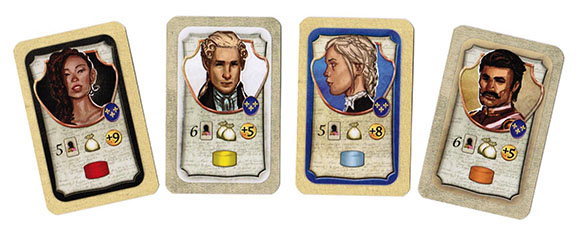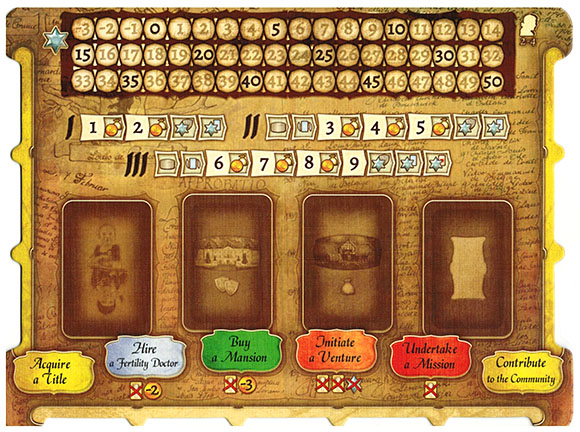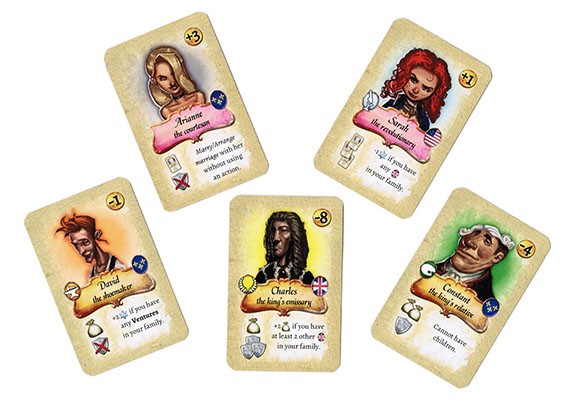
Legacy: The Testament of Duke de Crecy
Overview
A card game with worker placement at its core, Legacy: The Testament of Duke de Crecy (Legacy henceforth) is an engine-builder that eschews the usual city or civilization development in favor of building your family. Should you spend your precious time (and actions) betrothing your children to powerful families? Or is that effort better spent kissing the right… ahem… hands to try to secure a title? Maybe you should just blow off all that high society stuff and buy yourself a mansion. We have a lot to do, and only 3 generations to accomplish it in!
Set Up
Worker placement on cards sounds a bit inelegant, so it’s a good thing Legacy includes a main board and player boards to handle the action selection part of the job. The main board is laid out in the middle of the table, but it has a lot of stuff going on so you can’t just set it and forget it.

There are divots located on both sides and bottom of the main board to handle card placement. To the left you’ll need to arrange three face-up Generation 1 Title cards, and to the right three face-up Generation 1 Contribution cards. There are Generation 2 and 3 cards of each of these types you’ll place in a pile next to their Generation 1 siblings. With exactly three cards of each type for each generation, there is no shuffling required.
Below the main board resides Friend cards. You need to shuffle this 75-card deck and place it to the left of the board, then draw five face-up Friend cards and place them in the indentations.
There are four placeholders for decks on the board itself – these house the Child and Mission decks as well as Mansion and Venture cards. The 74-card Child deck and 15-card Mission deck have to be shuffled before placement. All Mansion cards are the same, as are Venture cards, thus requiring no shuffling – but the quantity of each used in a game is dependent on player count (3 in a 2-player game, 5 for 3-player, and all 7 for 4-player). Place the appropriate amount of each on the corresponding spot on the board.
To finish set-up of the main board a green round marker is placed at the beginning of the generation track and each player places a marker of their color on the “0” spot of the Honor track – this is the game’s victory point tracker.
Each player will next set up their player board. This simply entails placing the two remaining markers of a player’s color onto the “0” positions of the board’s Income and Prestige tracks. Two larger Action Pawns in each player’s colors are placed next to their personal boards.

Finally, each player is randomly assigned a Head of Family, a character they will start their family tree with. Each Head of Family card has a male and female side, and it’s entirely up to the player which gender will begin their lineage. The starting resources vary between families and genders – you’ll start with more immediately available cash if you start with a female, but have higher earning power throughout the game if you use the male side. Other resources – starting Friend cards and Extra Action Pawns – are fairly consistent between genders. Collect all resources your chosen Head of Family grants, and you’re ready to begin!
Gameplay
On the surface, what you do each round in Legacy is pretty straight-forward worker placement – you have two Action Pawns to use (plus a few potential additional actions explained below), and ten possible Actions to choose from (six on the main board and four on your player board).

But before we get to how the Actions work, let’s talk about what you’re pursuing. You’re going to create a family tree, starting with your Head of Family, that branches down three generations. You will choose a spouse for your Head of Family, have children, marry your children off and watch them have children. You’ll likely throw extravagant balls, earn increasingly important titles and build a status-symbol house or two. This is going to take up a lot of space on the table, so be mindful.
To start each round, every player is randomly given an Extra Action Pawn in one of five colors. The six Actions available on the main board are colored to match these Extra Action Pawns (two of the main board Actions share a color). The Extra Action Pawn you draw will determine which action you can take that round beyond your normal two Actions. In the first round you won’t draw the Extra Action Pawns randomly – a defined color will be granted to you by your Head of Family.

The most important Actions are located on your player board. Well, THE most important action along with three others you may or may not use. You can take these repeatedly in a round and can’t be blocked by opponents, but you can’t use Extra Action Pawns on these Actions (alas, they are a different color):
- Marry or Arrange Marriage: by using a Pawn here you can play a Friend card out of your hand and add it to your family tree. The cost of playing the Friend is determined by the card – you typically receive money for adding a female to your family (a dowry), while you have to pay to add a male to your family. Regardless of whether you paid or received the dowry, new Friends added to your family provide different benefits. You won’t get anywhere in Legacy without using this Action heavily. When you perform the “Marry” Action the resulting couple automatically has a child (drawn from the Child deck)… unless there’s a complication at birth. Yes, your happy-go-lucky newlywed couple can have their world crumble around them when your pull from the Child deck reveals a “Complication at Birth”. You’re going to have to lose the baby or lose the mother… you’re choice. Marrying is also the most reliable way to draw from the face-up Friend cards.
- Have Children: if one child is not enough for a new Mom and Dad – and it usually isn’t in Legacy – you can place Pawns here to have more children. If you’re not worried about the gender of your next child you can draw the top card of the Child deck for free. If gender is important (because, for instance, you have a hand full of male Friends and need daughters to marry them to), you’ll have to lose 1 position on the Honor track for the right to draw until you pull the selected gender. A Complication at Birth card, if drawn, will interrupt your plans regardless of whether you chose a gender or not.
- Ask Friends for Money: you can clandestinely petition friends for 2 gold with no penalty. If you need 3 gold it will cost you 1 position on the Honor track. If you need 4 gold it will cost you that position and force you to discard a Friend from your hand. Because nobody likes a beggar.
- Socialize: if you’re running low on Friends in your hand and need a refresh, socializing will allow you to draw a Friend card from the top of the deck for free (note you don’t claim one of the face-up Friend cards beneath the main board – those are earned in other ways). If you want two Friend cards it will cost you 1 gold; three Friend cards will cost you 2 gold.

Actions on the main board are limited – once somebody uses them they are off limits for the rest of the round. These actions are color-coded to match the Extra Action Pawns, so fate will frequently choose which of these you use:
- Acquire a Title: perhaps you feel your friends should address you as “Count”… maybe “Alderman”. Whatever it is you wish to be addressed by, this is where you get it. Titles allow you to advance the Prestige or Income markers (or sometimes both) on your player board, giving you the ability to earn more money and Honor as the game goes on. But titles are costly – they always require gold and the loss of a Friend or two.
- Hire a Fertility Doctor: having children – lots of children – is important in Legacy, and if you have the means this is the quickest way to bolster your family. You will be able to draw two children for one of your married couples, but it costs two gold and a Friend card from your hand. 18th century France really looked down on the reproductively challenged!
- Buy a Mansion: a vanity play in life, a rewarding vanity play in games. Each Mansion will cost you three gold and a Friend card from your hand, and will allow you to move your Prestige marker up two positions on your player board. Prestige’s usefulness is explained below.
- Initiate a Venture: Ventures operate similar to Mansions, but push your Income marker up two positions on your player board. If you’re struggling for money, this is the move you need to make. It costs 1 position on the Honor track and two Friend cards discarded from your hand. Friends flee when they sense the desperation in your need to work.
- Undertake a Mission:Missions are cheap in comparison to other main-board items – a measly one Friend discarded from hand. This is partly because they’re wildly variable. Missions give you hidden objectives to complete, and a reward for doing so. While the rewards are pretty consistent (usually moving 2 or 3 spaces forward on the Honor track plus additional game effects like drawing Friend cards or forcing opponents to discard) and the objectives are comparable (for instance, having two Russian family members or two family members with the “Scientist” occupation), you may have built your family in such a way that completing the Mission is extremely difficult. Or you may draw a Mission you’ve already completed. One aristocrat’s gold is another’s garbage.
- Contribute to the Community:Community Contribution cards work like Titles: they’re quite expensive (usually just gold), but allow you to advance your Prestige marker and allow you to draw cards. These are events you fund – a grand feast or debutante ball – to boost your standing in the community at great personal expense.

One round consists of each player alternately placing their Action Pawns until everyone is done. Players may or may not play Extra Action Pawns during a round, but they must play the Action pawns of their player color. Each Generation contains an increasing number of rounds: you’ll play two rounds in Generation 1, three rounds in Generation 2 and four rounds in Generation 3. Extra Action Pawns last through an entire Generation, so while you’re restricted to a particular Action to play them on, you’ll have two to four chances to play it depending on Generation. This mitigates the likelihood of opponents rendering your Extra Action Pawn useless by blocking a spot from you.
To win Legacy you need to finish the game with the most Honor. There are several routes to Honor; you can earn it through marriage or completing Missions… but these actions usually only move you a few spots. You can make big leaps in Honor at the end of each of the game’s three Generations: the Prestige value on your player board (determined by the position of your marker) turns in to Honor at each of these points. Advancing your Prestige track early – when you’ll be able to score it three times – is a great tactic, but requires efficient early planning
You can simply buy Honor in a few ways, such as Contributing to the Community. You’ll need a lot of gold to do this, and the best route to accumulate gold is the player board’s Income track. Just as Prestige translates to Honor at certain points in the game, Income is converted to gold. In fact, it is converted much more frequently – at the end of each round rather than the end of each Generation.
Components

Legacy‘s main board and player boards are outstanding. They are filled with completely logical symbols that eliminate the need to cross-reference the rulebook during play. They also serve to keep some of the incredible sprawl that Legacy is prone to in check: all of the cards managed by the main board can be crammed closely together to free up table space for your family tree.
The wooden bits – while simple discs – are robust and pleasant to handle. They also create a great color pallet for the game, a bunch of vibrant pieces thrown hither and yon in rapid succession.
But this is a card game… so how are the cards? Well, they’re not poker-sized cards, but the smaller 45mm x 70mm variety frequently used for weapons in boardgames. That seemed disappointing at first – after all, a card game should have grand cards – but then we started playing. A full set of poker-sized cards would make Legacy unplayable – it simply wouldn’t fit on most tables. The illustrations are usually playful and fun, lightening the mood of what could have been a “stuffy” theme.

One minor quibble: in lieu of providing cardboard coins to represent gold Legacy uses more cards. With table space at a premium, the publishers could have eased some of the congestion by allowing a small pile of cardboard rather than additional laid-out cards.
Learning Curve
Prior knowledge of worker placement or engine-building will certainly help, but Legacy isn’t the most challenging of middle-weight Euro games to pick up. The rulebook is an easy – although not short – read, and seems pretty air-tight – it doesn’t leave questions unanswered.
But the real learning curve minimizer for Legacy is the boards. Every step of every round of every Generation is represented logically through symbols on the board. Every Action is illustrated in a fashion that promotes understanding.
Who would enjoy this game?
Final Thoughts
So how much space does Legacy really take? Well, if anything you’re probably not thinking big enough. We play on a 4.5′ x 4.5′ table, and we can BARELY squeeze a 3-player game onto it. There is no chance we could get four – we had to do that on the floor. Not ideal.
Because all of the cards have to remain visible, and family delineation has to be accurate, you’ll need a space of about 2.5′ x 1.5′ just for your family tree. Then you’ll need room for your player board, gold, Action Pawns. And the center of the table needs room to hold the main board and all of its decks. This is a bit of a drag because the game is a blast.

It’s very rewarding searching for the perfect spouse for your son or daughter, or simply watching said child grow up (Child cards have a “youth” side and “adult” side, and they grow up between Generations – any arranged marriages become consummated marriages at the same time). You’re always planning and working toward securing your family’s future – a nice mirror turned to real life.
We talked about set-up, but not break-down. The sorting and packing away problem that exists with many multi-deck deck-builders is present in Legacy (to avoid confusion, this is not a deck-builder). At the end of the game each player is going to have to separate all of their cards – members of your family, Missions, Ventures, Mansions – into their appropriate deck. Break-down takes even longer than set-up. But this is just a nuisance that tags along with the rewarding experience that is Legacy. It is worth it.
Legacy also contains solo rules and components (yes – extra components to use only in solo games!) that make it work great solitaire. In fact, the solo game feels organic – not at all like an afterthought strapped onto a normally multi-player game. It’s great as a two-player game as well – it holds to its 60 minute estimate and you won’t have to worry about table space.
User Reviews (1)
Add a Review for "Legacy: The Testament of Duke de Crecy"
You must be logged in to add a review.

A common question from one friend to another, at least in the US, is “Where does your family come from?” We have a fascination with genealogy because very few of our families have been in the US for very long. My family has barely looked into its history, but it has always peaked my interest. As soon as I saw Legacy: The Testament of Duke de Crecy had a solo variant I thought that it had a very interesting theme, but I wasn’t sure how fun it would be. I mean, how much fun could it possibly be to research a fake family’s history? Turns out, quite a lot, but I’ll get to my opinion later.
courtesy of BGG
courtesy of BGG
courtesy of BGG
courtesy of BGG
In the multiplayer game you are competing to create the most influential family, marrying family members with the friends who provide the most advantageous benefits. In the solo variant, however, you are researching your family tree to prove whether or not you are related to a recently deceased, rich person. The friends become “known” family members and you are using their benefits to complete hints that tie you closer and close to the deceased.
In each generation you are given three hints, for a total of nine, that must be completed in order to claim victory. Using your guaranteed two actions you can identify specific members of your family as the “known” family members that you have received. You can also get small monetary gifts by identifying how rich your ancestors were, you can identify more “known” family members and several other actions that gain your prestige, income or honor points. Each of the family members you place into your family tree give you bonuses including more money, more actions, more “known” family members, etc.
courtesy of BGG
courtesy of BGG
The hints that you are trying to solve could be anything from “A male ancestor on your father’s side had a title,” to “Your grandparents had three children, one was a diplomat and the other married a Prussian.” Needless to say, some are much easier than others. The hints do not have to be solved in the generation in which they are revealed, but the sooner you can fulfill them, the better your end score. You have to manage your limited actions very well in order to complete each hint before the end of the game. It is not always easy, but it is a good challenge to and really works the brain.
What’s Good?
The limited actions makes for a very tough game. You have to make sure to use every action that you have to the best of your ability. One or two bad choices and it could mean a hint doesn’t get fulfilled.
Trying to manage the “known” family members and finding good combos to use is one of my favorite things to do. Timing when to put certain family members into the tree to get certain benefits in order to gain the title you need keeps me coming back to this game.
Hints in the last generation can really mess with your plan. Just when you think you have it all set up perfectly you get a new hint and have to find a Prussian to marry to your grandmother’s sister. That sounds like a negative, but I love it.
What’s Not So Good?
I never want to find out my ancestors are the ugly ones, but that isn’t really a negative, I just want my family to be pretty.
Having to think about whether a craftsman ancestor is the son or daughter of a noble or if your Russian great-grandparents had a Spanish daughter in order to not lose points is kind of annoying. It makes sense thematically, but I tend to not even pay attention to it at all.
What’s The Best Part?
Portal Games takes pride in the stories that are told in their games and this game is no exception. You could probably write a book on the family that you build and it is so rich in theme that is probably wouldn’t be that difficult to do either. I tend to talk about the family as I build it (yes that means I talk to myself) describing how one person was an outcast because they married the town fortune teller or how the underachieving craftsmen came from two noble parents. The stories are easy, and they are so good.
Originally posted on whoseturnisitanyway.com